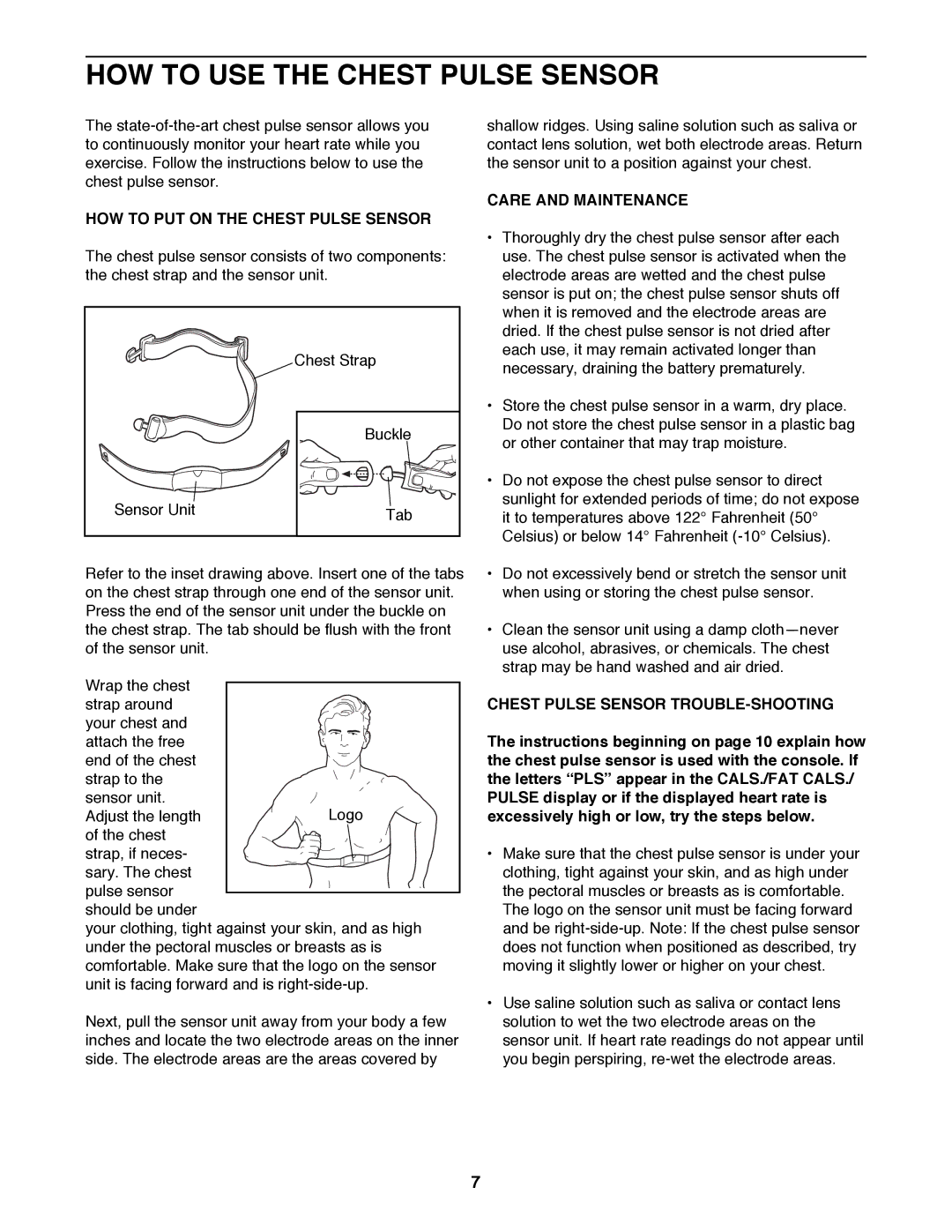
HOW TO USE THE CHEST PULSE SENSOR
The
HOW TO PUT ON THE CHEST PULSE SENSOR
The chest pulse sensor consists of two components: the chest strap and the sensor unit.
Chest Strap
Buckle
Sensor Unit | Tab |
|
Refer to the inset drawing above. Insert one of the tabs on the chest strap through one end of the sensor unit. Press the end of the sensor unit under the buckle on the chest strap. The tab should be flush with the front of the sensor unit.
Wrap the chest |
|
strap around |
|
your chest and |
|
attach the free |
|
end of the chest |
|
strap to the |
|
sensor unit. | Logo |
Adjust the length | |
of the chest |
|
strap, if neces- |
|
sary. The chest |
|
pulse sensor |
|
should be under |
|
your clothing, tight against your skin, and as high under the pectoral muscles or breasts as is comfortable. Make sure that the logo on the sensor unit is facing forward and is
Next, pull the sensor unit away from your body a few inches and locate the two electrode areas on the inner side. The electrode areas are the areas covered by
shallow ridges. Using saline solution such as saliva or contact lens solution, wet both electrode areas. Return the sensor unit to a position against your chest.
CARE AND MAINTENANCE
¥Thoroughly dry the chest pulse sensor after each use. The chest pulse sensor is activated when the electrode areas are wetted and the chest pulse sensor is put on; the chest pulse sensor shuts off when it is removed and the electrode areas are dried. If the chest pulse sensor is not dried after each use, it may remain activated longer than necessary, draining the battery prematurely.
¥Store the chest pulse sensor in a warm, dry place. Do not store the chest pulse sensor in a plastic bag or other container that may trap moisture.
¥Do not expose the chest pulse sensor to direct sunlight for extended periods of time; do not expose it to temperatures above 122¡ Fahrenheit (50¡ Celsius) or below 14¡ Fahrenheit
¥Do not excessively bend or stretch the sensor unit when using or storing the chest pulse sensor.
¥Clean the sensor unit using a damp clothÑnever use alcohol, abrasives, or chemicals. The chest strap may be hand washed and air dried.
CHEST PULSE SENSOR TROUBLE-SHOOTING
The instructions beginning on page 10 explain how the chest pulse sensor is used with the console. If the letters ÒPLSÓ appear in the CALS./FAT CALS./ PULSE display or if the displayed heart rate is excessively high or low, try the steps below.
¥Make sure that the chest pulse sensor is under your clothing, tight against your skin, and as high under the pectoral muscles or breasts as is comfortable. The logo on the sensor unit must be facing forward and be
¥Use saline solution such as saliva or contact lens solution to wet the two electrode areas on the sensor unit. If heart rate readings do not appear until you begin perspiring,
7
